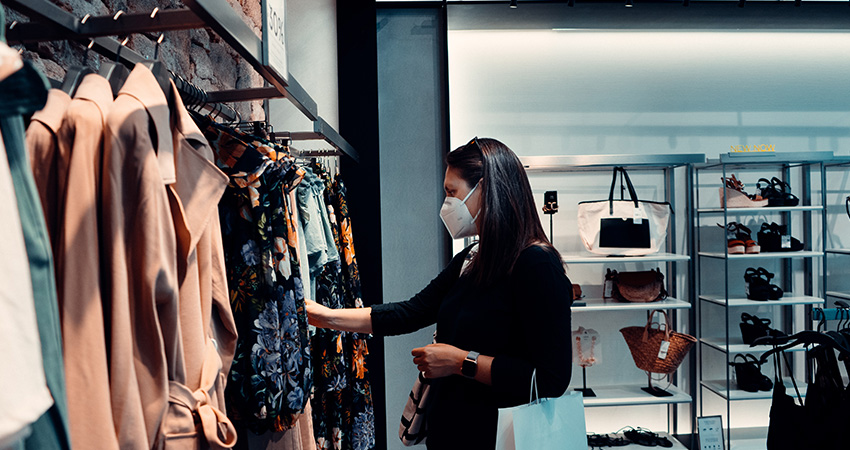Consumers are cautious (credit: Arturo Rey on Unsplash)
During the COVID pandemic, consumers have grown accustomed to a new standard of service from the companies they do business with. Innovative brands are offering conveniences and procedures that ease the burdens of living with the reality of COVID, and permanently altering customer expectations in the process.
Despite excitement over the global rollout of vaccines, the unknowns will still impact consumer sentiment and economic improvement. A constant flow of headlines reacting to market influences, such as the government’s national response, states lifting restrictions or the discovery of new COVID-19 variants means frequent shifts in consumer sentiment and behaviors.
To put it simply, things are constantly changing, and what consumers deem safe or reasonable is easily influenced by outside forces. Most anticipate that a return to normal will be a gradual and cautious process, even after the virus has been subdued, and different consumer segments will have varying levels of optimism on those timelines.
For advertisers, there are two critical ways to meet and exceed consumer expectations to keep and win business: building seamless digital experiences, and positioning products, services and experiences to appeal to differing consumer segments.
Building Seamless Digital Experiences
COVID has greatly accelerated our digital progress, giving us a new foundation for the next level of “normal.” Brands that have not yet adapted will need to catch up in order to stay relevant. For example, insurance and banking customers have increased their usage of and expectations around digital experiences.
While customers are comfortable turning to digital for some tasks, like deposits and mortgages, some still prefer going in person for others, like opening a new account. Most consumers will continue to use contactless payment, shop online for groceries and cook more at home, and a significant portion (40%) will continue to use telehealth services at elevated rates.
What’s most interesting to note is the demographic diversity of those who have adopted these new digital processes. Driven by necessity, the average age of digital users seems to have flattened, with both younger and older consumers integrating new digital experiences into their day-to-day routines. This could contribute to a heightened level of comfort with digital, leading to further expansion into new areas. More and more consumers will expect brands to provide seamless, integrated digital and offline experiences.
Positioning Based on Differing Situations, Mindsets
Despite excitement over the global rollout of vaccines, unknowns and inconsistencies will delay economic improvements. There is a cautious optimism among consumers; however, 50% of Americans still lack confidence in their personal financial situation, according to a Forbes/Ispos survey. As of February, 57% of consumers here feel the pandemic is either “out of control” or “getting worse,” according to Dentsu, although that is down 15 points from January. Still, 90% remain at least “somewhat concerned” about posed health risks.
The pandemic has had differing impacts across socioeconomic groups, but, for most, there is a trend toward prioritizing saving over spending, as consumers have become more deliberate with purchasing decisions.
It is important to understand what constitutes value for consumers and to position products and services accordingly. The retail, grocery and travel industries have all put new processes in place that finally, truly, put the customer first. However, these advancements are beginning to be rolled back in some spaces. For example, many airlines are no longer blocking middle seats and are reverting to less flexible change policies. Flexible travel polices could be enough to sway someone’s purchase decision; consumers want flexibility regardless of their financial situation.
Given the uncertainty around the true “end” of the pandemic, as well as its possible lingering effects, strategies must be kept nimble. Once safe to do so, keep in mind that “safe” has a different meaning for different groups. Some hope to return to pre-pandemic life immediately, while others will remain discerning about activity choices, and still others might continue to practice increased caution. Retailers must be aware of different segments’ comfort levels to be sure they’re continuing to meet customers’ needs and expectations.
Interestingly, a sunny day has the power to quiet some consumers’ minds and inspire hopeful or aspirational thoughts and actions. In the final week of February, when many areas saw unseasonably warm weather, seven of the top 10 selling items on Anthropologie’s website were dresses. Until that point “it was lucky to see just one or two dresses break into the top 10 list.” This is a departure from the loungewear pieces that had previously dominated sales. It leads us to consider whether our future behaviors will match our current-state assumptions of our future selves. Many people might have an aspirational mindset when thinking about the future, but may be more conservative when the time comes.
Even once safe to do so, many Americans plan to return to their lives gradually and cautiously. Marketers and advertisers must be aware that after experiencing a year of pandemic life, normalcy will not be flipping a switch. While vaccinations bring optimism, there is still uncertainty around the true “end” of the pandemic. Therefore, brands must continue to innovate, remain nimble and keep an eye on consumer behavior to meet and exceed their expectations. Keeping a pulse on signs of recovery and expectations that persist post-pandemic will be critical to survival.
Rachel Monfre is Media Strategy Associate Director at Merkle

